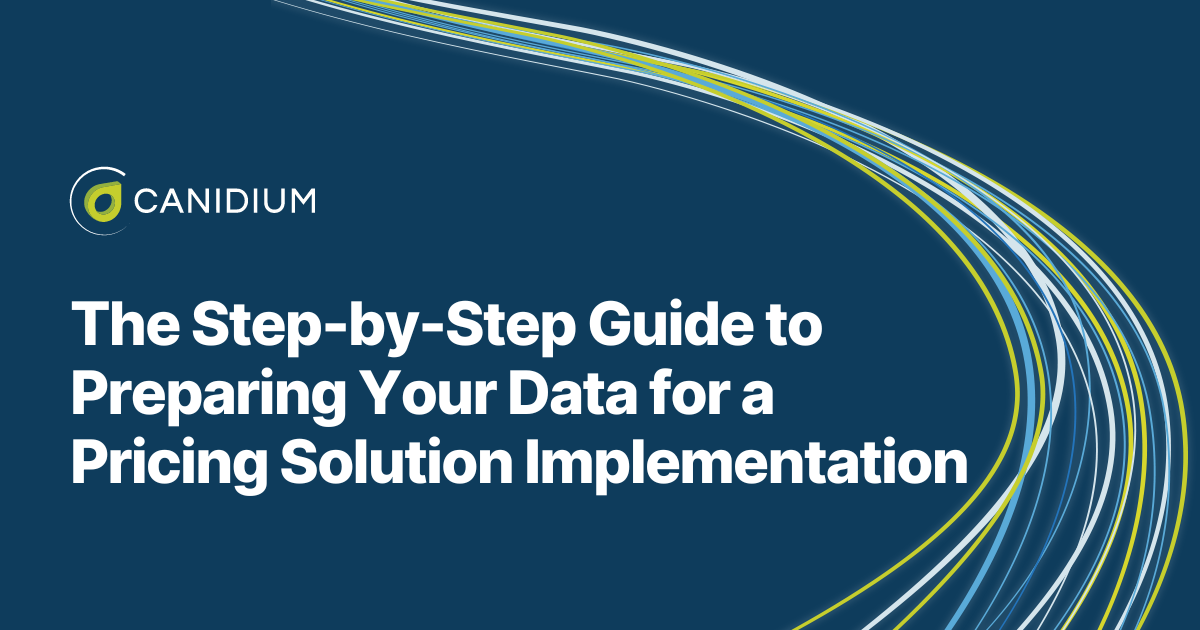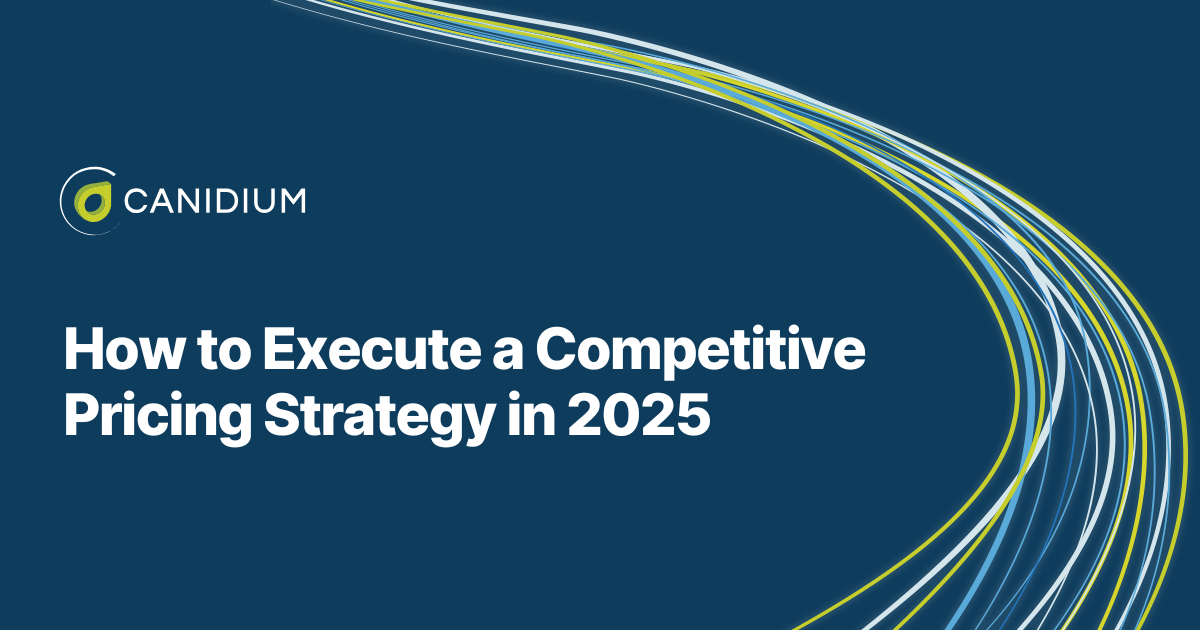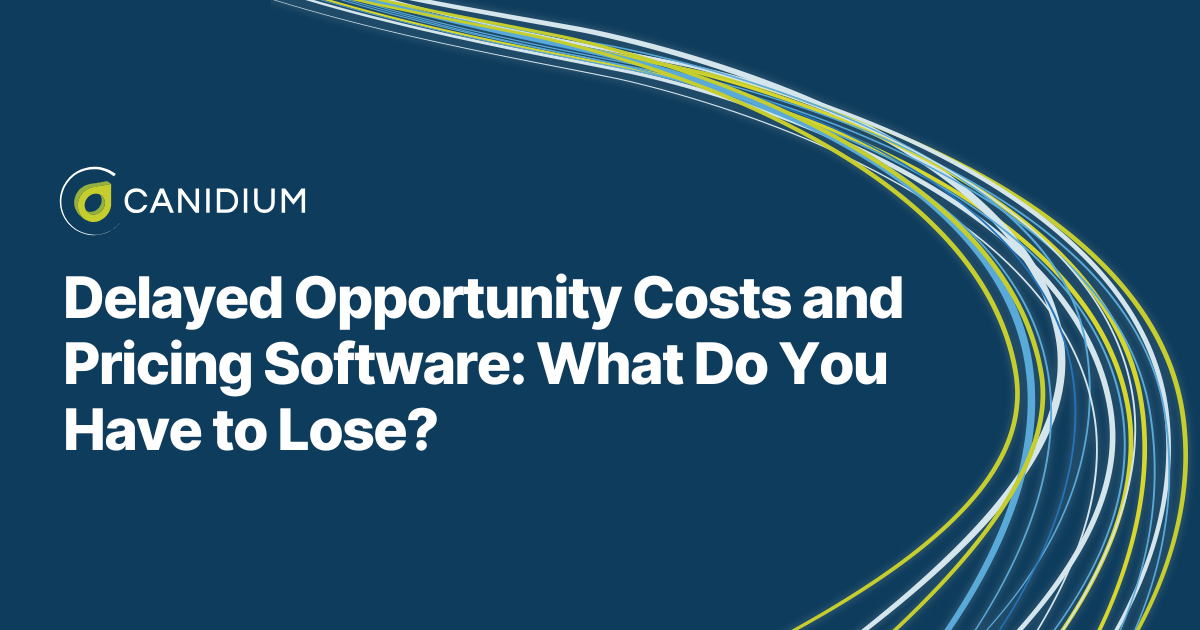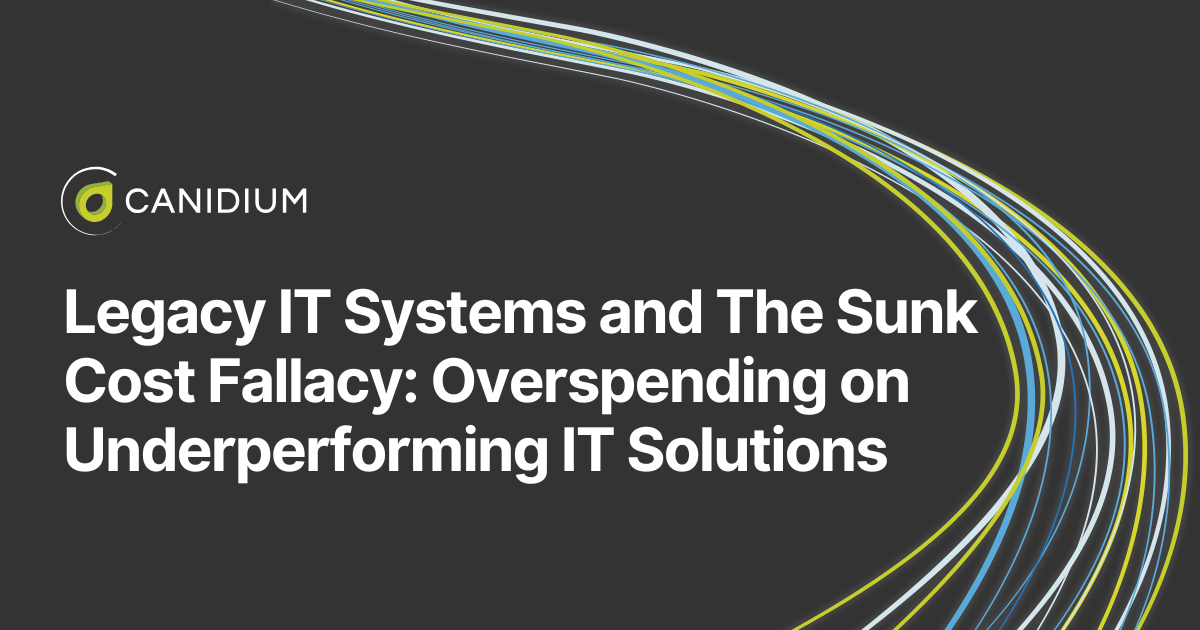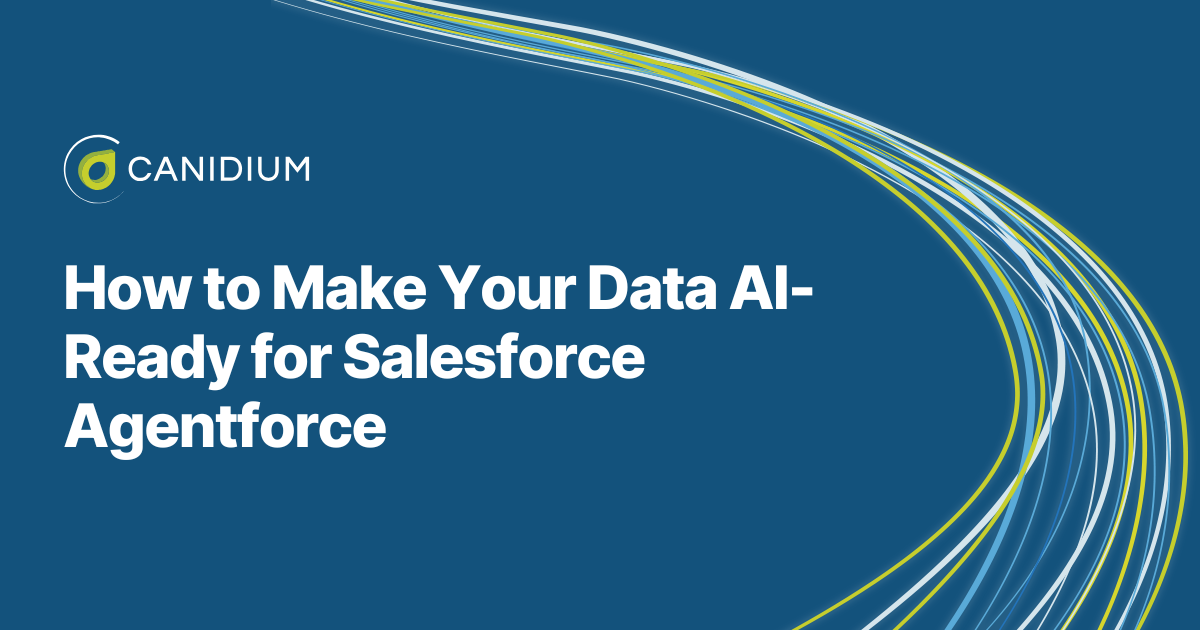Your implementation partner will handle the vast majority of your pricing solution project. Still, you must conduct internal housekeeping for your partner to successfully design and configure your new solution.
Preparing your data for implementation is one of the most critical tasks on your to-do list. The quality and accuracy of the data you feed into your pricing solution will largely determine the success of your investment.
Your internal team will be in charge of preparing your data. To cover all your bases successfully, you must understand how to prepare your data for a pricing solution implementation.
At Canidium, our team of Pricefx experts helps clients navigate the implementation process. We plan and configure pricing solution infrastructure to fit individual companies' data sourcing and reporting needs, giving us extensive familiarity with setting up successful data integration.
Based on our in-depth understanding of pricing solution implementations, this article takes you through the six steps you need to follow to prepare your data for implementation. More specifically, we will go through the following topics:
- What Does Unprepared Data Look Like?
- Problems That Can Arise With Unprepared Data
- The 6 Steps to Preparing Your Data for a Pricing Solution Implementation
- Data Preparation: Setting Yourself Up for a Successful Pricing Solution Implementation
What Does Unprepared Data Look Like?
Unprepared data is characterized by several key issues that can undermine the effectiveness of your pricing solution. It includes inaccuracies such as incorrect entries and outdated information, as well as incomplete data with missing points essential for analysis.
Inconsistencies arise when different sources use varying formats or definitions, leading to conflicting information. Redundant records create inflated data volumes, complicating analysis, while low-quality data often contains irrelevant information that obscures valuable insights. Lack of standardization makes it difficult to combine and compare data from various sources, and non-compliance with regulatory standards or internal policies poses legal and operational risks.
Recognizing and addressing these characteristics is crucial for ensuring a solid foundation for your pricing solution implementation. Your data is not ready for a pricing solution implementation if it contains inaccuracies, improper formatting, or missing entries. You will need to rectify these issues before your solution implementation during the data preparation process.
Problems That Can Arise With Unprepared Data
Your data is a foundational component of your pricing system. The efficacy of your pricing strategies and the revenue you generate from your new solution implementation depends on the quality of your data and how well it is managed.
Missing data, inaccuracies, and redundancies lead to faulty decision-making, potentially limiting the value of your pricing solution, thinning out your margins, and stunting your business growth. Unclean or incomplete data can result in inaccurate pricing models, leading to incorrect price recommendations that may harm sales or profit margins.
Poor data quality and mapping come at a high potential opportunity cost. You are missing the chance to optimize your pricing fully, dulling your competitive edge and reducing your profitability.
A lack of data preparation can also stall your solution implementation. Suppose you have yet to go through the preparation process. In that case, your software implementation (SI) partner may have to delay your project timeline to deal with poorly configured data. Subsequently, this extends the time it takes to achieve your solution ROI while increasing the time you incur the costs of your legacy pricing system.
At the same time, inaccurate data poses regulatory risks. It can lead to non-compliance with pricing regulations and standards, which may result in legal issues and fines.
Considering the impact of these factors, a lack of data preparation can erode stakeholder trust in your pricing solution project. Perceived discrepancies or issues with pricing structures can also negate customer trust. They may begin to view your business as unfair to patrons.
Combining these concerns raises the stakes for the data preparation process at the beginning of a pricing solution project. However, despite these potentially severe consequences, data preparation is a routine implementation process.
So long as you follow the proper data preparation procedures, you can eliminate these concerns and ensure you are drawing the maximum benefit from your system upgrade.
The 6 Steps to Preparing Your Data for a Pricing Solution Implementation
The idea behind data preparation is not just to ensure that your information accurately represents the realities it quantifies. While ensuring data quality is a critical step in the preparation process, there are other considerations to grapple with.
You will also need to find all the source data required to accurately understand pricing factors, map out how data will flow through your system, and ensure it is accessible for your SI partner to prevent implementation delays.
With all these tasks to accomplish, you must take several steps to ensure your data is entirely prepared. To help make the data preparation process simple, here are the six steps you should take early on.
.png?width=1920&height=1080&name=6%20(2).png)
Map Your Pricing Structure
One of the most overlooked steps in the data preparation process is identifying your existing pricing systems. Although it may seem that you already have a thorough grasp of how pricing works across departments, differences in pricing practices often go undocumented.
For example, if different departments or regions set their own prices, there might be variations that aren't immediately apparent. One department might use cost-plus pricing, while another relies on market-based pricing. Yet, another adjusts prices based on customer segments or purchase history. These differences can lead to inconsistencies and conflicts when implementing a unified pricing solution.
You must have comprehensive documentation of how pricing is structured in each practice. Before delving into your data sets, gather information from all departments involved in pricing decisions. This data includes sales, marketing, finance, and operations. Document their pricing strategies, rules, and any special cases or exceptions they handle. This information will give you insight into how to begin sourcing your data.
Discover Your Data Sources
A critical step in the data preparation process is identifying where your pricing data is stored and understanding how it is managed. Pricing data can reside in various systems and formats across your organization, and gaining a comprehensive view of these sources is essential for creating an effective pricing strategy.
First, identify the primary systems used to store pricing data. These often include Enterprise Resource Planning (ERP) systems, which manage core business processes and contain detailed transactional data. ERP systems can offer insights into historical pricing trends, cost structures, and inventory levels.
Customer Relationship Management (CRM) platforms are another key source, housing information related to customer interactions, sales history, and pricing agreements. CRM data can reveal customer-specific pricing arrangements and discounts, facilitating tailored pricing strategies.
Additionally, pricing data is frequently maintained in spreadsheets and standalone databases. Different departments might use these for ad hoc analysis, special projects, or legacy systems. While these sources can be fragmented and less standardized, they often contain valuable insights into departmental pricing tactics and exceptions.
Collect all these data sources so your SI partner can design a system that feeds this valuable information into your pricing software.
Scope Out Relevant Data
Data scoping involves defining your data's boundaries and focus areas to ensure you capture all relevant information while avoiding unnecessary complexity. Effective data scoping helps create a precise collection, integration, and analysis roadmap.
Start by identifying the specific objectives of your pricing solution. Determine what questions the data needs to answer and what insights are essential for achieving your pricing goals. For instance, are you looking to optimize pricing based on customer segments, historical sales data, or competitive pricing trends? Clarifying these objectives will guide your data-scoping efforts.
Next, categorize the types of data required. This process might include transactional data, customer demographics, market research, and competitor pricing information. Prioritize data that directly impacts your pricing decisions and supports your strategic goals.
Collaborate with key stakeholders, such as sales, marketing, finance, and IT departments, to understand their data needs and constraints. Their input will help identify critical data points and potential gaps in your current data landscape.
Consider the temporal scope of your data. Determine the historical data range necessary for accurate analysis and forecasting. Typically, a few years of historical data can provide robust insights into pricing trends and customer behavior.
Finally, you must assess the quality and completeness of the available data. Identify any data cleansing or enrichment activities needed to ensure accuracy and reliability. By thoroughly scoping your data, you can streamline the data preparation process, ensuring that your pricing solution is built on a solid foundation.
6 Steps to Honing Your Data Quality
Honing your data quality is essential for the success of any pricing solution. High-quality data ensures that your pricing models are accurate, reliable, and actionable, leading to better decision-making and improved business outcomes.
Poor data quality is a severe issue for companies across sectors. More than half of survey respondents reported that 25% or more of their revenue was affected by data quality issues. On average, the percentage of impacted revenue increased from 26% to 31% in 2022.
To avoid the consequences of low-quality data, you should take the following actions:
- Set Standards: Start by establishing data quality standards. Define clear criteria for data accuracy, completeness, consistency, and timeliness. These standards will serve as benchmarks for assessing and improving your data.
- Perform Auditing: Conduct a thorough data audit to identify existing issues. This process involves reviewing data sources for errors, inconsistencies, and gaps. Common problems include duplicate records, outdated information, missing values, and incorrect entries. Use data profiling tools to automate the identification of these issues and gain insights into the overall quality of your data.
- Cleanse Your Data: Implement data cleansing processes to address identified issues. This process may involve correcting inaccuracies, filling in missing values, standardizing formats, and removing duplicates. Regular data maintenance routines, such as periodic audits and updates, are crucial to sustaining high data quality over time.
- Enrich Your Data: Enhance data quality through enrichment. This process can involve integrating additional data sources to provide more context and depth. For example, supplementing internal sales data with external market trends and competitive pricing can offer a more comprehensive view.
- Set Governance Standards: Establish robust data governance practices. Assign data stewards responsible for overseeing data quality and ensuring adherence to standards. Implement policies and procedures for data entry, management, and access control to maintain consistency and accuracy.
- Encourage Best Practices: Foster a culture of data quality within your organization. Educate stakeholders on the importance of high-quality data and provide training on best practices for data management. Honing your data quality creates a strong foundation for your pricing solution, enabling more precise and effective pricing strategies.
By performing these steps, you can ensure that your new pricing solution operates with comprehensive and accurate information.
Ensure Your Data is Accessible
Access to the correct data promptly is essential for a successful implementation. Delays in receiving data sets can significantly stall progress. When data is readily available to the right stakeholders, it facilitates informed decision-making and efficient execution of pricing strategies.
Start by implementing robust data access controls. Define clear roles and permissions to ensure your SI partner can access data. This predefined access helps protect confidential information while making necessary data available to those who need it.
At the same time, understand your options for data extraction and identify which departments and teams will be involved. Consider whether there are middleware teams to account for and familiarize yourself with the timelines for each system from which you need to extract data.
By ensuring data accessibility, you minimize delays and ensure your pricing solution's smooth and successful implementation.
Loop in Your Implementation Partner
Your SI partner's expertise in handling data can significantly enhance the quality and efficiency of the preparation phase. Communicate your data-related goals, timelines, and expectations to leverage your SI partner during this process. Ensure your partner understands the specific data requirements, including the types of data needed, the sources of this data, and any particular constraints or challenges. This transparency allows them to tailor their approach to better support your needs.
Involve your implementation partner in initial data assessment meetings. Their input can help identify potential data quality issues, integration challenges, and gaps in your current data landscape. Collaborating closely lets you leverage their expertise to develop a robust data preparation strategy.
At the same time, you should establish regular communication channels with your partner to keep them updated on data-related progress and issues. Schedule frequent check-ins to discuss data extraction, cleansing, and integration tasks. This ongoing dialogue ensures that both parties are aligned and can promptly address any problems.
The goal is to work together to create a detailed data preparation plan, including milestones, deliverables, and responsibilities. This plan should cover data sampling, manual extraction, and the transition to fully automated data processes.
Involve your partner in the testing and validation phases to ensure data accuracy and completeness. Their familiarity with the system and the data can help quickly identify and resolve issues, leading to a smoother implementation.
By looping in your software implementation partner during the data preparation process, you create a collaborative environment that enhances data quality, reduces delays, and ensures a more successful project outcome.
Data Preparation: Setting Yourself Up for a Successful Pricing Solution Implementation
Preparing your data for a pricing solution implementation is a critical task that can significantly influence the success of your project. Although your implementation partner will handle much of the project, your internal team's role in data preparation is vital. The quality and accuracy of your data will largely determine your new pricing solution's effectiveness and return on investment.
Data preparation is a structured process that starts with mapping your pricing structure to understand existing pricing practices across departments. Identifying and consolidating your data sources ensures all relevant information is available for the new system. Scoping helps define your data's focus areas and boundaries, ensuring you capture essential information without unnecessary complexity.
Honing data quality through auditing, cleansing, and enrichment activities ensures your data is accurate, complete, and reliable. Establishing robust data governance practices and fostering a culture of data quality within your organization further supports this effort. Ensuring data accessibility by implementing access controls and understanding extraction options helps prevent delays and facilitates efficient project execution.
Finally, looping in your software implementation partner during the data preparation process enhances the quality and efficiency of your efforts. Clear communication, regular updates, and collaborative planning with your partner ensure alignment and prompt resolution of any issues.
Now that you have a plan for preparing your data, your next step is to learn more about the other implementation process your team will take the lead on. Read more about preparing for Pricefx user acceptance testing here.


